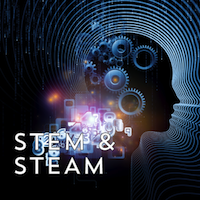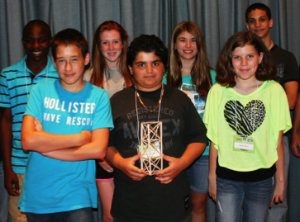5 Hot Topics in STEM Education
A MiddleWeb Blog
 NOTE: It’s 2020 and we’ve updated this popular post by adding links to four other articles by Anne Jolly that have a similar focus (see the list below).
NOTE: It’s 2020 and we’ve updated this popular post by adding links to four other articles by Anne Jolly that have a similar focus (see the list below).
And there are quite a few more! Explore all of Anne’s posts by browsing our STEM by Design category here at MiddleWeb.
As you kick off the school year I wonder: How has your STEM program morphed over the last 12 months and what it will look like now? If this is your first year for a STEM program, what does it look like in its initial stages?
ALSO SEE THESE POPULAR POSTS!
Real World STEM? Try Plastics Pollution.
Build Skills with Quick STEM Mini-Lessons
How to Make or Find Good STEM Lessons
Use a STEM Launcher Activity to Engage Kids
In both cases, I’m wondering how you are addressing some of the hot topics in STEM. This year the National Academy of Engineering and the National Research Council published a joint report, STEM Integration in K-12 Education: Status, Prospects, and an Agenda for Research that identifies a variety of unresolved questions about what pre-collegiate STEM programs should “be.”
What decisions are you making about these issues?
1. How will we define STEM in our schools?
What does your STEM program look like? Are you implementing S.T.E.M. or STEM? In other words are you focusing on (1) adding or strengthening individual STEM subjects such as higher level science and math? Or (2) are you focusing on an integrated approach where all subjects must come together to solve an engineering challenge?

Both industry and higher education want students who can innovate, create, and be entrepreneurs. Classes in which students “sit and get” all period, doing their work individually, lack the culture of inspiration, discovery, and innovation that students need to require to fully develop those skills. Which way does your school want to go?
2. Is there a role for Arts in STEM?
This issue is causing some real brain strain as people try to wrap their heads around how to integrate arts (the “A”) into STEM. Maybe you are working with a STEAM program. How are you developing that program in a way that is true to both STEM and the Arts?
A lot of ideas for including art-related content simply don’t hold true to the basic principles of STEM. I’ve curated a number of useful articles on STEAM here. And this blog post offers some possible criteria for decisions about STEAM programs.
At my request, three guest bloggers for STEM by Design weighed in on this issue:
Ruth Catchen remarked: “I think there is a big difference between what a fine artist does (whether it be music, dance, drama or visual art) and how art is approached in industry for design or to sell something.”
Carolyn DeCristofano agreed: “There are talented artists whose work might not be said to be ‘practical’ or ‘useful’ in the material sense of that word. Then again, the reality is that there are others who engage in using art to serve some purpose. I worry about whether STEM and arts integration might shortchange the arts by emphasizing only those practical applications.”

Carolyn concluded with the question that anyone developing a STEAM program needs to ask: “What is unique about the arts that we need in STEM? And what can STEM do to help with education in the arts (the doing and making of art)?”
Answering that question will require a lot of thought and some degree of risk-taking. Go for it!
3. We depend on diversity
According to Ben Ingham in STEM Magazine (p.17) our nation’s security and economic prosperity depend on a highly educated work force with advanced skills in STEM. Science, Technology, Engineering and Mathematics are the foundation of industry and commerce in America. But you know that.

Making a decision to target minority groups puts pressure on K-12 schools to better recruit, involve, and prepare these students. That can be an exciting development! This post on girls in STEM suggests three ways to avoid inadvertently excluding girls. These suggestions can also apply to minorities. While not all students will choose a STEM career, being engaged in classes that inspire them – that offer a culture of creativity, discovery, and innovation – will prepare them to live fuller lives and make the world a better place in any career.
4. Providing STEM for ALL
Making STEM available to all students is an idea your school must consider. Think about this: School X offers a special afterschool STEM program. Is that sufficient? Certainly quality afterschool STEM programs are valuable; however the ultimate goal of STEM is to prepare all students to be STEM literate. One teacher put it this way:
“I can’t help but think that some of these special programs are somewhat elitist. It’s great that motivated, well-prepared students get these opportunities, but I’d be more enthusiastic about STEM if there were more focus on helping all students develop the mathematical, scientific and technological literacy they will need to function as effective and informed citizens.”

5. Keeping up with technology
Wow! This STEM component is moving so fast it’s hard to keep up. What will your school be offering in the technology realm? Coding for all students? Gaming as a way of learning content? Those ideas are spreading and catching fire. Keep in mind that a technology program in and of itself is a good thing. However, a technology program that interfaces with STEM is what you’re looking for in a STEM program.

Those are five hot topics to think about as you plan, kick-off, or improve your existing STEM program. Get these on your STEM radar and make them part of your STEM blueprint and commitment.






























I was interested in the STEM/STEAM discussion. I realize these folks are not educators, but there are a lot of professional artists/musicians/novelists with a formal education in math and science. It would be interesting to see what they bring to their art from their STEM background, and/or how they integrate (or do not integrate) their artistic and scientific careers.
That would certainly be an interesting topic Anjie! STEM and the Arts seems a natural blend, and many artists I know are also good mathematicians and scientists (and vice versa). There’s definitely some sort of connection there. Now how can I locate these folk . . .
Any ideas, anyone?
I’m looking for a list of middle schools in my area that are STEM or STEAM schools. Do you know where I can a resource for these schools? Thanks!
As far as I know, there’s no general resource listing middle schools in your area that are STEM or STEAM schools.The closest online site that might have that information is Change The Equation. You can click on a map there and see what’s going on in your state. Hope that helps!
what is the common title for this?
for thesis. :(